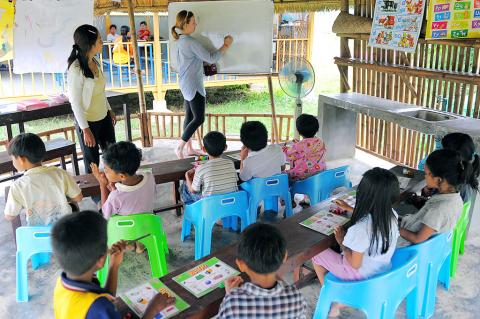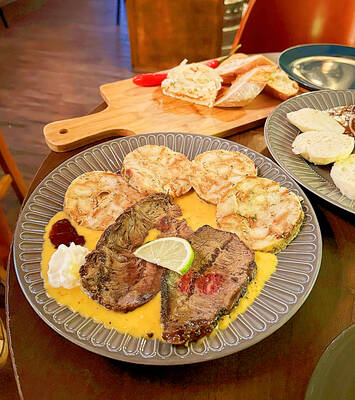Pictures of hundreds of former volunteers line the walls of a muddy courtyard in Cambodia’s tourist hub of Siem Reap, their faces once familiar to the orphans playing there but now long gone.
The colorful gallery at the Acodo orphanage illustrates a growing trend of holidaymakers donating their time and skills to children in the impoverished country — but experts fear they could be doing more harm than good.
Marissa Soroudi, a student in her 20s from New York, is one of the many volunteers teaching English at Acodo, near the famed temples of Angkor and home to more than 60 orphans between the ages of three and 18.

Photo: AFP
The young American, who pays US$50 a week to work at the orphanage, plans to stay for a few days before traveling on but she knows it is tough on the children to watch volunteers like her come and go.
“There are so many people volunteering that it’s kind of like, one leaves and another swoops in,” she said.
“They say better not to talk about it with them. Don’t say ‘I’m leaving in a week,’ don’t do any of that because then they get upset. Better to just not come.”

Photo: AFP
Short-term volunteers may have good intentions, but childcare experts say they are putting some of the most vulnerable children at risk.
“Constant change of caregivers gives emotional loss to children, constant emotional loss to already traumatized children,” Jolanda van Westering, a child protection specialist at the United Nations Children’s Fund (UNICEF) said. “And the constant exposure to strangers poses risks of harm, of violence and abuse, because we know that oftentimes volunteers come to an orphanage without having their backgrounds checked.”
As the gateway to the ancient temples of Angkor — which attract more than a million visitors a year — a steady stream of tourists passes through the sleepy riverside town.
And many want to do more than just sightsee in one of the region’s poorest nations.
On notice boards in hotels, cafes and souvenir shops, wide-eyed children stare from posters for schools and orphanages, encouraging travelers to donate time and money for their particular cause.
“Visitors see some poverty and they feel bad about it,” said Ashlee Chapman, a project manager with Globalteer, an organization that matches volunteers with local organizations.
“They want to do something,” she adds, saying they might visit a children’s project for a few hours, donate money and toys, “take a holiday snap and feel that they’ve contributed.”
As the so-called volunteer tourism sector flourishes, so too does the number of institutions housing children.
In the past six years, the number of orphanages in Cambodia has almost doubled to 269, housing some 12,000 children, according to UNICEF.
Friends International, a local organization that works with marginalized urban children and youths, says tourism has contributed to the increase.
Visiting orphanages has become a tourist “attraction” in big cities like Phnom Penh and Siem Reap, said Marie Courcel, alternative care project manager at Friends International.
That in turn encourages the institutionalization of youngsters, many of whom are very poor but actually have at least one living parent, she said.
Only one in 10 of the orphanages are funded by the state, the rest rely on charitable contributions to survive.
At Siem Reap’s Acodo, huddled with the children in the shade of the only tree, Soroudi organizes the afternoon activity.
Following her lead, the orphans make headpieces out of grass and add licks of paint to green and yellow conical hats, costumes they will wear in that evening’s traditional Khmer dance show.
The daily half-hour event attracts a tourist crowd who thank the young performers with donations of money.
Van Westering said she worried about the dangers for children who are expected to raise funds for their care by begging or putting on shows for tourists.
“They have to do their best and they hear that also if they don’t there isn’t enough money for their care,” said Van Westering. “You can just imagine what that does to children to live in that kind of insecure environment.”
Her advice to tourists pondering a brief working stint at an orphanage is simple: “Don’t go. Give blood, support a community-based organization that provides day activities for a child but where the children go home at night.”
Betsy Brittenham, an interior designer in her 50s from Arizona, and her 15-year-old daughter Alex are spending three weeks as volunteer teachers at one such place, the Grace House Community Centre, where the children return to their families each evening.
The mother and daughter team, who planned their trip months in advance, say volunteering at a reputable center is a chance to make a difference in a country with fewer resources and opportunities than their own.
Like the volunteers at Acodo, Betsy pays for the privilege of working on her holiday but she sees no downsides to the experience.
“When you volunteer like this you’re bringing your money and you’re making tremendous strides and teaching their children,” she said. “It’s something you can’t put a price on.”

Seven hundred job applications. One interview. Marco Mascaro arrived in Taiwan last year with a PhD in engineering physics and years of experience at a European research center. He thought his Gold Card would guarantee him a foothold in Taiwan’s job market. “It’s marketed as if Taiwan really needs you,” the 33-year-old Italian says. “The reality is that companies here don’t really need us.” The Employment Gold Card was designed to fix Taiwan’s labor shortage by offering foreign professionals a combined resident visa and open work permit valid for three years. But for many, like Mascaro, the welcome mat ends at the door. A

If China attacks, will Taiwanese be willing to fight? Analysts of certain types obsess over questions like this, especially military analysts and those with an ax to grind as to whether Taiwan is worth defending, or should be cut loose to appease Beijing. Fellow columnist Michael Turton in “Notes from Central Taiwan: Willing to fight for the homeland” (Nov. 6, page 12) provides a superb analysis of this topic, how it is used and manipulated to political ends and what the underlying data shows. The problem is that most analysis is centered around polling data, which as Turton observes, “many of these

Divadlo feels like your warm neighborhood slice of home — even if you’ve only ever spent a few days in Prague, like myself. A projector is screening retro animations by Czech director Karel Zeman, the shelves are lined with books and vinyl, and the owner will sit with you to share stories over a glass of pear brandy. The food is also fantastic, not just a new cultural experience but filled with nostalgia, recipes from home and laden with soul-warming carbs, perfect as the weather turns chilly. A Prague native, Kaio Picha has been in Taipei for 13 years and

Since Cheng Li-wun (鄭麗文) was elected Chinese Nationalist Party (KMT) chair on Oct. 18, she has become a polarizing figure. Her supporters see her as a firebrand critic of the ruling Democratic Progressive Party (DPP), while others, including some in her own party, have charged that she is Chinese President Xi Jinping’s (習近平) preferred candidate and that her election was possibly supported by the Chinese Communist Party’s (CPP) unit for political warfare and international influence, the “united front.” Indeed, Xi quickly congratulated Cheng upon her election. The 55-year-old former lawmaker and ex-talk show host, who was sworn in on Nov.